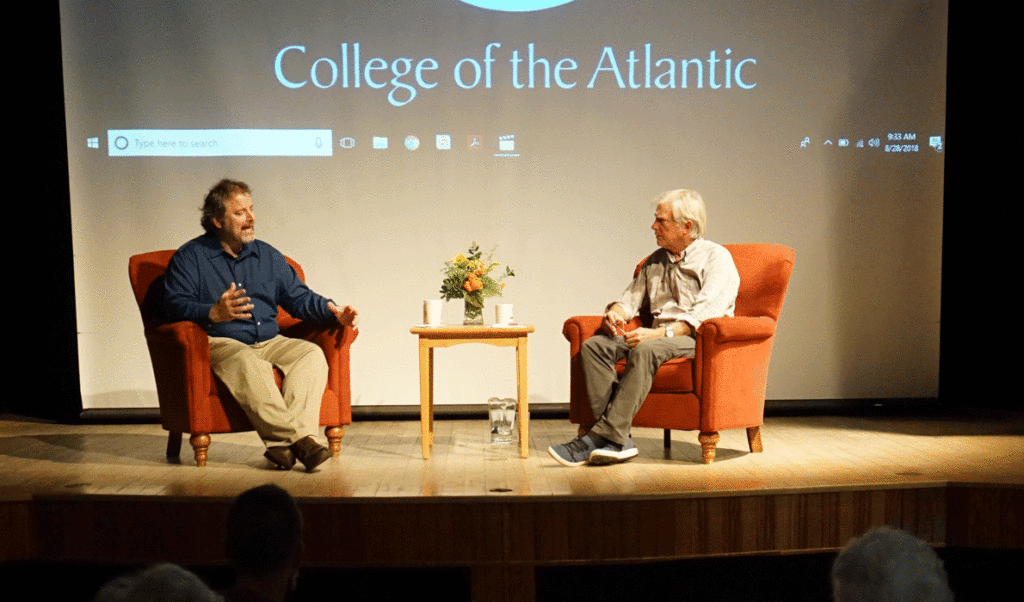During introductions at the Aug. 28 installment of “Coffee and Conversation,” a summer series at Bar Harbor’s College of the Atlantic, a joke was made about the school’s opening session tradition of having students and staff jump into the cold Atlantic Ocean off Bar Island to swim to the campus on the shore of Mount Desert Island.
“It’s our intelligence test,” quipped the college’s Sean Todd. “Most people fail,” he deadpanned, meaning they actually complete the swim.
Later in the discussion with guest David Shaw, a noted ocean researcher, Todd said that as the Gulf of Maine has warmed in recent years, Great White sharks have been seen in Maine. So yes, he said, the swimmers could, in theory, encounter those large, powerful sharks.
The lighthearted exchange illustrated some serious themes that emerged in the conversation between Todd and Shaw.
Todd is a professor who specializes in oceanography and marine mammals, and who also is director of Allied Whale, the college-based nonprofit that studies and works to rescue whales.
Shaw’s lengthy resumé includes serving as co-chair of the Aspen Institute’s High Seas Initiative, working with the American Association for the Advancement of Science, founding chairman of the Sargasso Sea Alliance, and founder of and CEO of Maine’s IDEXX Laboratories.
Shaw explained the concept of the “high seas,” recounting the changes in international law in his years of professional work. For decades, the waters within three miles of a state’s shore were controlled by that state, with the three-mile measure historically related to the approximate distance of a cannon shot. That was expanded to 12 miles, and now, “All countries have an extended-economic zone 200 miles from their shores,” Shaw said,
The oceans beyond that 200-mile limit are considered the “high seas.”
Two-thirds of the planet’s surface is covered by oceans, and half of that is outside the jurisdiction of national governments. So much of those high seas have yet to be explored, Shaw and Todd explained, and so much is at risk of being exploited.
Sharks are a species that are particularly threatened in the unregulated high seas, Shaw said. They also illustrate the lack of scientific information about what happens in these offshore waters.
Shaw worked with others earlier this year tagging Great White sharks off Monterrey Bay in California, and the fish were tracked via satellite.
“It showed us the greatest animal migration on the planet,” he said, with many of the animals congregating in an area of open ocean roughly between California and Hawaii, dubbed the White Shark Café by researchers.
As many as 100 million sharks from several species are believed to be killed annually, Shaw said, 80 million for their fins which are used in making shark fin soup, a food favored in Asia.
In his presentation, Shaw showed an image of large dump truck full of fins. He said former NBA star Yao Ming of China has lent his image to the campaign to stop harvesting sharks for soup.
Shaw quoted fellow ocean researcher Sylvia Earle: “Until you know, it’s hard to care.” He likened the slaughter of sharks for their fins to the late 19thcentury practice of shooting buffalo from the windows of trains.
“They can do, essentially, whatever they want out there,” Shaw said, as various countries send subsidized fishing ships out to harvest vast catches. “These subsidies are helping plunder the commons,” he said.
There is reason for optimism, both Shaw and Todd said.
Just over 2 percent of oceans have protective regulations, Shaw said. But much of the Sargasso Sea—an area measuring 2 million square miles near Bermuda, which Shaw described as “the great golden rainforest of the Atlantic Ocean”—has been protected from harmful fishing practices.
An effort is now underway to get the United Nations to adopt environmental protocols for the high seas.
Another example of the rich opportunity to learn more about the ocean, Shaw said, came from studying waters in that region at depths of 100 meters (328 feet). Researchers learned there is a layer of carbon found at that depth, but much more could be learned about why it is there and how it functions.
“The ocean produces about 80 percent of the air you’re breathing right now,” Todd told the audience. “This is the engine that drives our planet. It’s time to look after the ocean.”
Oceans, which are warming at unprecedented rates, are the biggest influence on weather, Shaw added.
“When we’re talking about saving the oceans, we’re talking about saving ourselves.”





